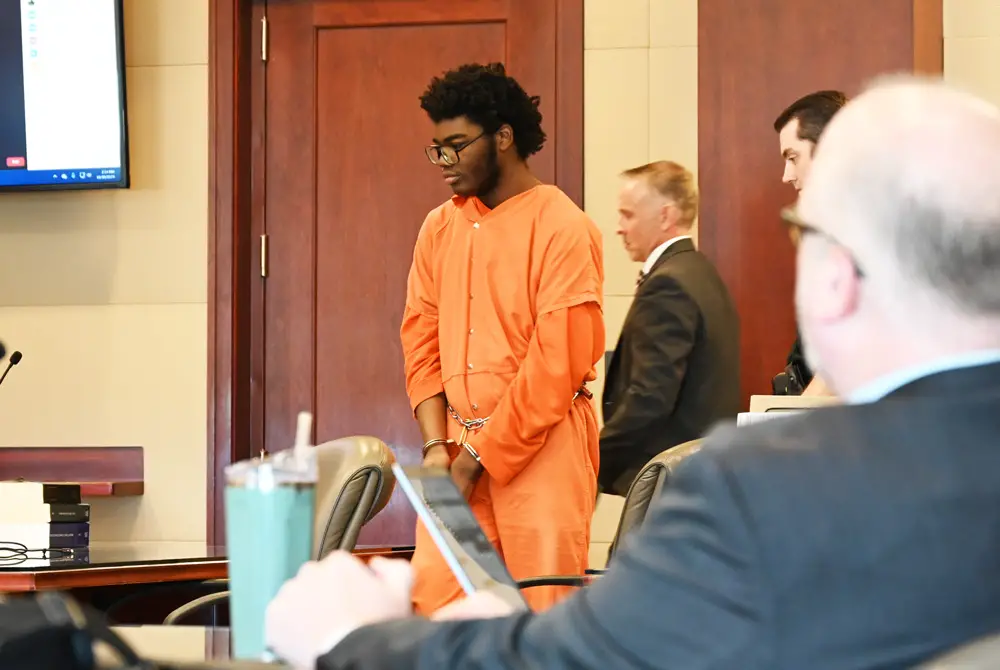
Last February when he was a 17-year-old special education student at Matanzas High School, Brendan Depa attacked his paraprofessional, Joan Naydich, in a hallway, knocked her unconscious and pummeled her until staffers separated him from her. He was arrested and eventually charged as an adult with a first-degree felony count of aggravated battery on a school employee. In October he pleaded to the charge. It’s an open plea, leaving it to Circuit Judge Terence Perkins to sentence him on Jan. 31.
Gene Lopes is a retired special education teacher who has spent the last several months tutoring Depa at the Flagler County jail. Here’s his experience.
![]()
By Gene Lopes
First let’s address the elephant in the room: I support Brendan Depa. And I support Joan Naydich.
Since the horrific events of Feb. 21, when Brendan, then a student at Matanzas High School, brutally beat up Ms. Naydich, his paraprofessional, after an incident that involved the removal of an electronic device, some very good people felt they had to choose sides.
When I say good people, I don’t include those who have called Brendan an animal, those who have called for him to be put down, those who have called his parents horrible or his mother a manipulator who wants to absolve Brendan of any responsibility for his actions. I won’t dwell on haters who seem to have ulterior motives perhaps resulting from issues of their own. The truth is that both Brendan and Naydich are victims in this case.
Since that horrible day, I have gotten to know Brendan Depa better than most people in this community. I am his tutor at the Flagler County jail, bringing my 30 years of experience as a special education teacher to the table. As Brendan’s sentencing day approaches (on Jan. 31), I would like to share my experience with him, and to give you a perspective that may not change your mind about him, but that should at least be part of the conversation.
I will also provide my own analysis, based on my examination of the record–both Brendan’s education records and his educators’ records–of a context that to this day has not been made part of the conversation, and that should be: without justifying the violence one iota, it is important to understand what happened that day beyond the viral videos, the press reports and the mountains of assumptions that risk burying the human beings beneath them, Brendan among them.
With the help of the Flagler County Sheriff’s Office and Chief Daniel Engert, who heads the agency’s Court and Detention Services, I have gotten to work with Brendan as a tutor for the last several months. I must acknowledge the incredible program being run by Sheriff Rick Staly and Flagler County Vocational College to help incarcerated individuals to better their lives by working toward GEDs or developing vocational skills as electricians, plumbers and cooks. I have gotten to meet some of these people and am very impressed with their desire to improve their lives. I worked with Brendan in that context.
Brendan is everything his mother has told us he is. He is engaging, funny, smart, sensitive and inquisitive. Brendan is also guarded, childlike (for example he is still passionate about Pokemon), impulsive, naive and a bit defensive.
Brendan is unlike any student I have worked with in my 30 years. His vocabulary and technical writing skills are in a superior range. He is a prolific writer who is presently writing two books. He is an artist. At our first meeting Brendan asked me: “Would you like me to draw you a picture of the main character from my book?”
He writes songs, which he has sung to me. One of his songs is a Pokemon rap song. It is clever, cute and complex all at the same time, and it is clean. Brendan is also an avid reader of fantasy novels. He enjoys reading and is only limited by not having access to more reading material. Brendan will tell you that he does not like math and is not good at it but he has demonstrated the skills necessary to be a good math student.
Brendan and I have discussed his past actions. But it is not my place to speak for him, other than to convey what he always says: that he is sorry.
I have also seen Brendan get frustrated. Ironically, this was because I could not spend more time with him. I was able to softly explain to him that if leaving early on some days was going to be a problem, I would only come on days when I could stay for three or four hours. I asked him to decide what he wanted me to do. In other words, we talked it out. By doing so, he calmed down and decided that he would like me to come whenever I could, even if it was only for an hour or two.
Like so many of my friends with autism (I still have weekly contact with many of my former students, who are now in their 20s and 30s), Brendan has a unique awareness of how people feel about him. He has seen the compassion of Chief Engert and many other detention deputies at the Flagler County jail.
He is also working to understand other inmates who may be looking to take advantage of him or to set him off. He is a very easy target in the prison population.
Brendan is also very aware of the anger and hate that many people in the community hold against him. At one of our last sessions together, he suddenly stopped working, looked me straight in the eyes and said: “A lot of people hate me. Why don’t you?”
Wow. I have never thought about it. I had to tell him that when I first saw the video–the video that went viral, that shows Brendan beating Naydich unconscious–I was pretty much like everyone else who was angry and upset at what he did. It was not until I read his mother’s article about his life that I changed how I felt. (See: “Brendan Depa’s Mother Tells Her Son’s Story.”)
I told Brendan that I realized that he was a person who made a horrible mistake, but a person who deserves a second chance. Who among us does not? Who among us would be where we are, had we not been given second, third or more chances?
Let me now address a few things about Brendan’s time at Matanzas High School, up to that fateful day.
Both Naydich and the teacher of record, Barbara Buchanan, were in the first year of new careers in education. My point is certainly not to blame either but to suggest the lack of sufficient training and preparation that Naydich and Buchanan received when taking on the task of working with students who have emotional/behavioral disabilities (EBD). Both Naydich and Buchanan took on assignments that very few people are willing to even attempt. They certainly did not get into it for fame and fortune. They were hired by a school district facing a severe staff shortage, and that needed bodies in the classroom.
This led to a relaxation of state mandated requirements for new teachers and paraprofessionals. I am drawing this conclusion based on my analysis of records obtained through public record requests. It appears from these records that both Naydich and Buchanan did not complete many required hours until after the incident. These requirements are not just for the benefit of the student but also as a way of keeping teachers as safe as possible. As a comparison, for me to teach Special Education in New Jersey, I earned a bachelor’s in Special Education, a master’s in Learning Disabilities, and completed 100 hours of professional development every five years.
Over my 30 years as a special education professional, I have probably worked with more than 100 students with autism or behavioral disorders. I have been kicked, punched, spat on, bitten, had a desk thrown at me, had a computer smashed on my feet, cursed, screamed at (once by a parent), along with many smaller incidents.
Most times these behaviors were the result of a student having a bad day. Sometimes they were the result of other students inciting a student. On more than a few occasions, the incidents were the result of something I did. I never intentionally set out to upset a kid. But sometimes my good intentions blew up in my face. For the record: I loved my job and miss it every day. To help me with my withdrawal symptoms, I have been very fortunate to sub at Buddy Taylor Middle School alongside amazing staff and administrators over the last two years.
Every special education student has what’s called an Individualized Education Program, or IEP for short. An IEP is not just “guidelines” that we can use when working with classified students. It is a legal document that teachers and schools are required to follow with each individual student. The IEP is a mandated component of the Individuals with Disabilities Education Act (IDEA). So, in a self-contained class, each student will have a completely different IEP. Sometimes it feels like we are juggling chainsaws. Most days talented teachers and their paras figure out how to make it work. It can take years. It is never perfect even over time.
Brendan’s behavior plan, which I have obtained and reviewed with his mother’s permission, had a list of 25 elements that teachers and paras should implement to keep everyone safe while in school. Among them were:
“Utilize a token economy and allow him opportunities to earn tokens (level reward system) to cash in for tangible or edible items.” Brendan’s reward system was working. Without consulting Brenbdan’s mother, the teacher made a decision to change the system–to allow Brendan to earn time playing video games on a handheld device. The removal of handheld devices was a well known trigger for Brendan as stated in previous IEPs and evaluations. I am sure that no one anticipated the degree of Brendan’s response. But a response should have been anticipated.
“Avoid correcting, reprimanding, or redirecting Brendan in the presence of peers as student has a history of becoming verbally aggressive and defiant when approached this way.” The escalation of this conflict all happened in front of other students.
“Do not take comments personally, and use planned ignoring.”
In 2025, we will celebrate 50 years since the landmark legislation called the Education For All Handicapped Children’s Act, now known as Individuals with Disabilities Education Act (IDEA). This law recognized that every child, regardless of his or her disability, is entitled to a free and appropriate public education. The act not only protects the students, but also the rights of parents.
The law was intended to make all states, counties and school districts responsible for the well-being of all of our children. The question needs to be asked: did we fulfill this responsibility to Brendan Depa, and are we continuing to punish him for having autism by incarcerating him without addressing his mental health issues?
Incarcerating a young man with the emotional maturity of a 5 or 6 year old does nothing to heal Joan Naydich’s physical or mental scars and does not make society safer. It can be a valuable lesson to all school districts that we need to do a better job caring for our students with disabilities, which will also make our teachers and paraprofessionals safer.
Brendan Depa, like so many others, is a product of a system that is exhausted, overwhelmed and understaffed. The Depa family seems to have done everything humanly possible to help Brendan, only to run into bureaucracy and roadblocks that forced them to send him three hours from home and into a public school system unprepared to meet his unique needs.
It is time that the judicial system finds a safer and more therapeutic setting for Brendan. I speak from 30 years of experience when I say that Brendan is not a lost cause. He is an 18-year-old young man who needs our help and our support. It takes a village is not a pretty turn of phrase. It is an essential reality in which many of us play a role, in which some of us must play that role.
Without any question, the time I have spent with Brendan over the past two months has been the most rewarding work that I have ever done. The staff at the jail has gone out of their way to get Brendan to me four or five days a week. During this time Brendan has dedicated himself to working to better himself both academically and as a person. He works tirelessly throughout our sessions of two hours or more and with some luck he will take the first section of the GED before the end of the month.
He has also used this time to reflect on his actions, behaviors and the consequences of his behaviors. Again, I will not speak for Brendan but I can attest to a remarkable change in attitude and overall demeanor. He has developed some real coping mechanisms for dealing with frustration and anger. Not that this should matter or play into how we see him, but he has also lost about 65 pounds and little resembles the person we saw in that horrible video.
Brendan’s case can be an opportunity for our community to come together to improve our schools, expand our knowledge of people with autism and other disabilities and to make our community a safer place for all of us. My wife and I are now beginning our fourth year as residents of Flagler County and have never been happier. We continue to be amazed at the compassion of our new hometown. Brendan Depa is worthy of your empathy and compassion.
![]()
Gene Lopes, a Palm Coast resident and retired educator, was a special education teacher in New Jersey public schools from 1993 to 2022, and an adjunct professor at Kean University from 1999 to 2020. He continues to tutor Brendan Depa at the Flagler County jail.
![]()









